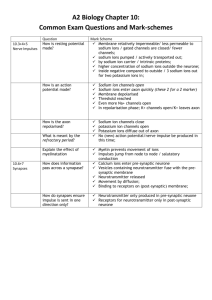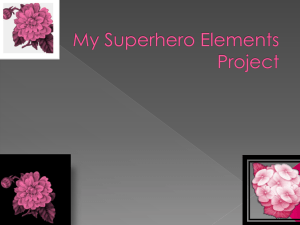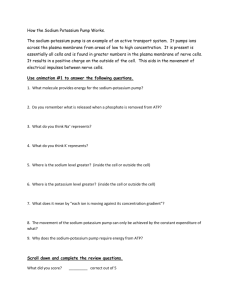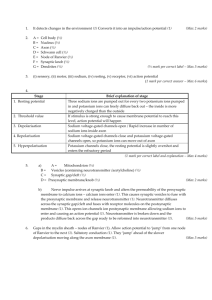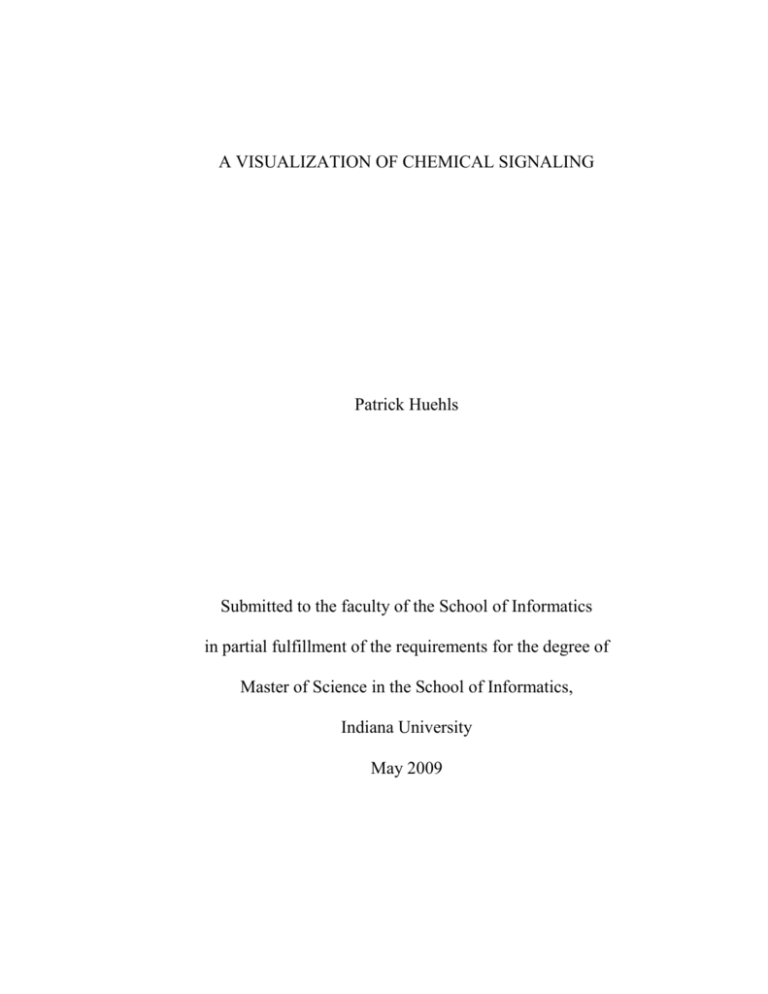
A VISUALIZATION OF CHEMICAL SIGNALING
Patrick Huehls
Submitted to the faculty of the School of Informatics
in partial fulfillment of the requirements for the degree of
Master of Science in the School of Informatics,
Indiana University
May 2009
TITLE PAGE
Start 2”
Accepted by the Faculty of Indiana University,
in partial fulfillment of the requirements for the degree of
Master of Science in Chemical Informatics.
____________________________________
Mathew J. Palakal, Ph.D., Chair
____________________________________
Theodore R. Cummins, Ph.D.
___________________________________
Grant D. Nicol, Ph.D.
ii
© 2009
Patrick Huehls
ALL RIGHTS RESERVED
iii
Acknowledgements
The events that led to this production are associated with individuals who helped,
taught, inspired, and led me in my academic pursuits. Had there not been a School of
Informatics at the IUPUI campus, I would not have sought an advanced degree. The
interdisciplinary nature of informatics particularly appealed to me.
In fall semester of 2001 I took Chemistry C371. Here Dr. Gary Wiggins introduced
me to informatics from the perspective of a discipline in which I had some training. Dr.
Kenny Lipkowitz patiently taught me how to use the online tools.
Nearly a year later I started exploring the M.S. in Chemical Informatics program. My
first contact was Mary O‟Neil, who continued throughout to help me navigate the
administrative requirements. She also introduced me to Dr. Sam Melosivich, who was to
become my first academic advisor. He really helped me stretch my brain around
informatics.
Spring of 2004, I took C372, molecular modeling, with Dr. Kelsey Forsythe, who
would eventually become my second academic advisor. He really expanded my mind
about what was included in chemical informatics. I was also really taken by the
robustness of the visual output form molecular modeling software.
Early September of 2004, as my first classes in the program were starting, William
Aspry assembled a conference at IU Bloomington about the research agenda for
informatics. Not only did this give me an exceptional overview of the field I was
entering, but I also met Albert William, who became my gateway for exploring
iv
visualization in chemistry. He has been helped me tremendously on my journey through
this program.
Albert suggested that I take a course that in 3D modeling and animation. In fall 2005,
I enrolled. It was taught by Clint Koch, who has continued to help me build on what I
learned in his class.
In October of 2005, Clint loaned me a DVD of productions that were presented at
SIGGRAPH (ACM) in 2003. One of the productions was a description of DNA
replication by Drew Berry (WEHI). I had seen several conceptual presentations of this
process in lectures before but had somehow postponed my understanding of it. In less
than half a minute of watching Berry„s video I suddenly and thoroughly comprehended it
so acutely that it took my breath away. I wanted to understand how this happened to me
in more depth.
I first looked to Dr. Paul Pietsch, an anatomist whom I had met decades earlier
during my undergraduate work in Bloomington. He helped me understand that my
answer was not in the locus of structural anatomy of the brain.
Later that year I met Dr. Karl Mac Dorman. When he joined our faculty, I sought his
view on how Berry‟s video provided such a cognitive leap for me. In spring of 2006 I
took his Psychology of Human Computer Interaction course. He helped me understand
that the exercise of construction can be a path to research just as well as analysis.
Chemical signaling within and between cells was something I had been hearing and
reading about. Much of it seemed very obscure. It seemed it would be an interesting
challenge to construct what chemical signaling looked like.
v
After a semester of looking around for someone to guide me in this, I found Dr.
Grant Nicol in the School of Medicine. He helped me also recruit Dr. Theodore
Cummins for my research committee. Together they provided the guidance and feedback
that shaped the production and technical accuracy.
After the departure of Dr. Forsythe from the department, Dr. Matthew Palakal
generously agreed to chair my committee.
I am also indebted to my family for giving me the space and support to return to
being a student after so many years outside academia.
.
vi
Preface
At the orientation session for new students to the School of Informatics in the Fall of
2004 there were introductory remarks by Dr. Darryl Bailey in which he described
Informatics as “Data becoming information, becoming knowledge, becoming wisdom”.
Much of the coursework for Chemical Informatics focuses on the beginning step of data
becoming information. I see this thesis project as the construction of a teaching tool by
facilitating information to become knowledge via application of the tools of informatics.
vii
TABLE OF CONTENTS
List of Tables.................................................................................................................... ix
List of Figures................................................................................................................... x
Chapter One: Background ................................................................................................1
Chapter Two: Production
Overview.................................................................................................................. 10
Rationale for Visual Components............................................................................ 11
Visual Components....................................................................................................12
Compositing.............................................................................................................. 13
Summary of Software ...............................................................................................13
Chapter Three: The Underlying
Science...........................................................................................................................11
References..................................................................................................................... 15
Curriculum Vitae
viii
Tables
Table 1: Visual Components and Rationale…………………………………………. 6
Table 2: Models and Construction Information…………………………………….. 8
Table 3: Software Applications Used……………………………………………….10
ix
Figures
Figure 1: Schematic Overview of the Production Process……………………………. 5
Figure 2: Ion Channel Molecular Structure from Protein Databank
Imported into Maya…......……………………………………………………………. 7
Figure 3: Potassium Channel…………………………………………………………12
Figure 4: The Stages of the Cycle of a Sodium-Potassium Exchange Pump……….. 13
x
Chapter One: Background
Physical sciences are based on observation. Much observation cannot be directly
visual because of the size, time scale, or proximity of the subject matter. For example the
objects studied in the field of nuclear physics exist on a very small scale and move very
fast compared to the scale and perceptual capabilities of humans. Innovative scientists
have discovered methods to measure and characterize this subject matter by measures
such as energy change. The data from experimentation is mostly numerical.
Science disciplines use the advantage of the visual system in gaining understanding
of numerical data. Plots of data reveal relationships that are obscure when viewed as
tables of numbers. For more complex data sets, visual data mining tools are gaining
popularity (Simoff, 2008). In chemistry, none of the interactions on the atomic or
molecular scale are visible. Yet the structure of many molecules has been determined by
crystallography techniques enabling construction of geometrically accurate 3D models of
molecules that make their spatial relationships and interactions readily understandable.
Animation of 3D models adds further to comprehension (Höfflerand, 2007). Moving
images reveal more about complex shapes of objects (e.g., molecules) by moving the
viewpoint to reveal the unfamiliar geometry.
The human visual system gives us the ability to detect fine grained features and
patterns in images more quickly than in other information representations such as text
(van Wijk, 2006). It has also been suggested that the use of images in teaching can
substantially enhance student comprehension (Kolb, 1973).
Visual representations are useful in creating educational experiences that simulate
visual observations of the objects and phenomena of science. For example, medical
1
illustrations have long been integral to curricula in medicine. While our internal organs
are so close, they remain obscure, because flesh is opaque. Illustrations of anatomy allow
a view inside. In-Silico interactive simulation can provide an even more robust substitute
for real life observation with the addition of interfaces that provide tactile feedback.
One of the earliest serious efforts to create multimedia productions including
visualizations of concepts of science was a series of educational films produced by Frank
Capra with sponsorship from Bell Laboratories starting in 1957. The most popular of
these, Hemo The Magnificent, was an explanation of the human circulatory system for
young students. It was shown in secondary schools as part of the science curriculum
throughout the United States. The production mixed film with 2D animations for science
education rather than entertainment, where such media had gotten its start. Multimedia
use in science education has since flourished. Many science textbooks include a disk with
multimedia content to supplement comprehension by the student.
Scientists eventually took this to the level of using multimedia presentation for
communicating with one another about their research. An early example of this was done
at the National Institutes of Health in 1968 (Fitzhugh, 1968). The evolution of this use in
communications between scientists has led to publications such as the Journal of
Visualized Experiments (JoVE) for communicating complex laboratory methods in the
life sciences.
While the multi-media visual representations based on non-visual scientific
observations have proven useful, there is ambiguity as to where they belong in the
taxonomy of science and art. ACM SIGGRAPH and IEEE have provided forums for
demonstration of such productions as well as journals for discussions on this topic. Much
2
of the discussion about this pivots on the value of visualization. Van Wijk (van Wijk,
2006) discussed this in some depth, concluding that the value is dependent on the
discipline from which it is considered. Construction of visual solutions to problems of
science have brought accomplishments such as the determination of the double helix
structure of DNA and the discovery of the source of the cholera epidemic in 1854 (Tufte,
1990).
The unique contribution of this project is the use of real molecular structure data in
the robust audio- visual explanation of ion currents in nerves. The challenges
encountered primarily surrounded how to process published molecular structural data to
turn it into 3D models that could be appropriately manipulated to animate the description
of the initiation and conduction of ion currents that are nerve signals. To address this for
large molecules such as sodium and postassium channels, molecular modeling software
was used to prepare a molecular surface depiction that could be saved as a file type that
could be converted to be compatible with the 3D modeling and animation application.
For smaller molecules, models were constructed in the 3D modeling application that were
visually similar to those produced in the molecular modeling application but less data
intensive.
3
Chapter Two: Production
Overview
The starting point for this visual production was the goal of using reported molecular
structures in a robust explanation of the workings of some aspect of chemical signaling in
living systems. The specific topic of sodium and potassium channels in initiation and
propagation of nerve impulses suggested itself as an illustrative example. The objective
was further defined to make a visual presentation that would be useful in teaching about
the role of these ion channels in nerve signal initiation and propagation to graduate
students in the School of Medicine. Defining this specific topic and target audience
provided a frame of reference for the construction of the production. Figure 1 shows a
schematic overview of the production steps.
In further discussions with the research committee, a general story line was developed
that included: the description of how sodium and potassium channels worked in this role;
what results when they do not function properly (description of a diseased state); and
some historical perspective on some of the scientists and their key discoveries that led to
the current understanding in the field. Figure 1 shows the steps in the production process.
4
Figure 1: Schematic Overview of the Production Process
A detailed script of the narration for the production was written along with the
preparation of a storyboard describing the corresponding visual components. An
anamatic, or draft, of the production was assembled from the recorded script and sketches
and other coarse grain representations of the visuals. The anamatic was used to determine
the flow and transitions within the presentation and generate data about how long each
visual component needed to be on the screen.
Rationale for Visual Components
Every image that appears on the screen has a planned purpose. The images and their
related animation are coordinated with the narration to optimize communication of the
subject matter. Table 1 summarizes the visual components and rationale.
5
Description
Source
Birds in flight
Video
Bird in tree
Video
Human hand
Video
Human profile
3D model
Graph of resting potential
Composite of 2D
images
Composite of
3D models and
2D images
Composite of
3D models and
2D images
Composite of 3D
Models
Composite of 3D
models and 2D
images
3D model
Potassium channel in nerve cell
membrane
Sodium – Potassium exchange
pump in nerve cell membrane
Nerve ending
Nerve axon with patch clamp
Nerve axon with myelinated
regions
Sodium channels and DNA
molecule
Brain, dendrite network and
multi-trace chart
3D models
Composite of 3D
model and 2D
images
Video
Reenactment of tonic-clonic
convulsive seizure
Sodium channel and images of
drug molecules
Composite of 3D
models
Images of scientists and figures
related to their research
Image of Sodium channel and
of publications related to more
current discoveries
Composite of 2D
images
Composite of 2D
images
Rationale
The flight of birds is familiar to the audience while the
underlying suggestion is that this complex behavior is
possible due to sensing and signaling systems that operate the
birds‟ specialized anatomy.
The focus on a single bird is coordinated with the narrator
indicating that the scope is limited to part of one of the
signaling systems.
Familiar part of human anatomy communicates that what
follows is about human systems.
Familiar image reinforces that human systems are the topic.
Provides coarse grained overview of what is to follow.
Familiar image from science provides transition to finer
grained explanation that follows.
More robust version of potassium channel image presented in
textbooks is familiar to audience while animation
demonstrates function described in narration.
More robust version of image sequence presented in textbooks
is familiar to audience. Animation and text description
emphasize that this is an active rather than passive process.
This is the finest grained and most realistic of all visual
components as it approaches the molecular scale.
Coarser grained depiction of impulse propagation familiar to
audience because similar to textbook images and laboratory
experience.
Model is familiar to audience as it is based on textbook
images. Animation emphasizes conduction rate difference
from non-myelinated regions.
Random activity of sodium channels introduces their role in
epilepsy and DNA image suggests its hereditary nature.
Images and related animation emphasize that the misbehaving
Sodium channels leading to epileptic symptoms are located in
the brain.
Provides realistic view of a common type of epilepsy related
seizure that audience may reasonably see in the course of their
careers.
Animation of drug molecules moving to different locations on
the Sodium channel emphasizes that different drugs act on
different locations of the channel.
Images emphasize the span of time over which discoveries
were made that enabled study of ion channels.
Images of publications give audience a view of what they may
reasonably encounter in the course of their careers.
Table 1: Visual Components and Rationale
Visual Components
Visual components were video, 2D images, and 3D models. Video was shot, captured,
and edited by the author. 2D images were created with Adobe® Photoshop®CS3, taken
as photographs of 3D models, or sourced from the World Wide Web as cited. With the
6
exception the human figure, which was purchased from turbosquid.com, 3D models were
constructed in Autodesk® Maya®. Molecular 3D structures were obtained from Protein
Databank and subjected to other processing steps before importing into Autodesk®
Maya®2008 for texturing and inclusion in the respective scenes. Figure 2 shows a screen
capture of a protein molecule after importation to Maya. Table 2 summarizes the 3D
models that were constructed.
Figure 2: Ion Channel Molecular Structure from Protein Databank Imported into Maya
7
Model
Construction Information
Membrane Surface Texture
This texture is based on electron micrograph of neural membrane surface
showing hexagonal packing of the heads of the phospholipid membrane
components (Levitan, 2002). It started with a textured field of spheres
captured as a 2D image that was then used as texture map on a larger
sphere. The larger textured sphere was duplicated into a field of
hexagonally packed spheres then captured as a 2D image. This image was
made into a tileable image and used as both texture map and bump map for
the membrane surfaces used in the various scenes.
Potassium Channel (cartoon
image)
Based on 2D illustration (Purves, 2001), the potassium channel in cross
section is a composite of two 3D models with opacity of each animated to
depict opening and closing. The membrane is an arrangement of planes
with texture and bump maps.
Sodium-Potassium Exchange
Pump (cartoon image)
Based on 2D illustration (Nicholls, 2001) and 2D animation (McEvoy,
2003), the pump is a 3D model animated by use of a blend shape. The
membrane is an arrangement of planes with texture and bump maps.
Nerve Ending
Based on micrograph of nerve ending (Levitan, 2002), the shape was
revolved from a hand drawn profile. The membrane surface texture was
mapped to the 3D shape.
Closed Ion Channel (molecular
structure)
Started with Protein Databank (.pdb) structure imported into Chimera and
defined it as a surface model. The model was then exported as a Virtual
Reality Mark-up Language file. It was then converted to a Maya Ascii file
using vrml2ma.exe. It was opened in Maya, textured and rescaled. It was
then imported to each scene where used.
Open Ion Channel (molecular
structure)
Started with Protein Databank (.pdb) structure, then subjected to the same
steps as the closed ion channel
Ion Emitters
Emitters were created using Maya‟s dynamics options. Emitted particles
were redefined as blobby surfaces and textured to represent the respective
ions.
Ion Fields
Ion fields were created with Maya‟s particle tool and animated by applying
a turbulence field. The particles were redefined as blobby surfaces and
colored to represent the respective ions.
Nerve Axon
The axon was created in Maya via extrusion of a circle along a hand-drawn
path. It was then textured with the membrane texture.
Myelin Sheaths
Based on 2D illustrations (Purves, 2001) and stained micrographs (Caceci),
myelin sheaths were created in Maya as pipes that were sized to the axon
proportional to the textbook images. A texture map was hand-drawn in
Adobe Photoshop using colors sampled form stained micrographs of
myelin.
Table 2: Models and Construction Information
8
Animation of the models was accomplished by setting key frames for position,
opacity, distortion or other properties of the models or the virtual camera which is the
viewpoint for the output of the scene. Timing of the key frames was determined from the
recorded script such that what the viewer would see would fit with what the narrator was
communicating at any given point. The final step in Maya® is to render the scene. In
this process, Maya® calculates what each pixel should look like based on the model,
lighting, special effects and other specified properties. It repeats this process for each
frame in the specified range. As the final production plays at thirty frames per second,
the rendered output is thirty 2D images for each second of the production.
Compositing
In the compositing process, the visual components were assembled and synchronized
with the narration to create the final output, which, in this case, is a digital movie. This
was done with Adobe® Premiere® Pro 2.0 and Adobe® After Effects® CS3
Summary of Software Used
Multiple software applications were used for the variety of specific tasks required in
this production. Table 3 lists the role of each application used.
9
Application
Use
Adobe® After Effects® CS3
Compositing
Adobe® Premiere® Pro 2.0
Compositing and final video output
Adobe® Photoshop®CS3
2D Image manipulation
Autodesk® Maya®2008
Create 3D models and output image
sequences for compositing
UCSF Chimera
PC Model® (Serena Software)
Sony Sound Forge
Manipulate molecular models and convert
to Virtual Reality Mark-up Language
Build and manipulate molecular models
Edit sound
Table 3: Software Applications Used
10
Chapter 3: The Underlying Science
Ion channels are specialized protein molecules that are found in cell membranes
across the entire taxonomy of flora and fauna. These channels are located in the cell
membrane and function to selectively allow specific ions in or out of the cell. Through
their selectivity, they advantage ion concentration differences between the inside and
outside of the cell to provide the necessary driving force to rapidly move ions across the
cell membrane (Nicholls, 2001). This thesis project provides a multimedia explanation of
how sodium and potassium channels work in tandem in nerve cells to transport electrical
charges in the form of ions that function as signals in the nervous system.
Two levels of chemical signaling are involved in the initiation and propagation of an
action potential. On the molecular level, stimuli lead to a response, which is a change in
conformation of the ion channel. On the cellular level, diffusion of ions through the open
ion channels, driven by concentration gradients, enables the initiation and propagation of
a discrete bolus of electrical charge along the length of an axon. Such electrical signals
constitute information transfer within the organism. This cellular level phenomenon is the
focus of this project.
When a nerve cell is at rest, it maintains a potential sixty-five millivolts lower inside
its membrane compared to its surroundings. This difference in potential results from
different ion concentrations inside and outside the cell, which is accomplished by
potassium ions diffusing out passively through potassium channels, and sodium-
11
Figure 3: Potassium Channel (adapted from Nicholls, 2001)
potassium pumps moving three sodium ions out and two potassium ions back in with
each cycle. These pumps move sodium and potassium ions across the cell membrane
against their respective concentration gradients by an active molecular process that is
powered by adenosine triphosphate, which binds to and phosphorolates the pump
molecule causing a change in conformation (Nicholls, 2001).
12
Figure 4: The Stages of the Cycle of a Sodium-Potassium Exchange Pump (adapted
from Nicholls, 2001)
Nerve signaling starts with a stimulus from an organism‟s environment. In this case,
it is a sharp pinpoint pressed to the skin. This mechanical deformation causes stretchactivated sodium channels in underlying nerve endings to open. This, in turn, allows a
rapid inflow of positively charged sodium ions, changing the electrical charge in the
nerve endings.
As the electrical charge in a nerve ending becomes more positive and exceeds a
threshold level, proximal voltage-activated sodium channels open in response, resulting
in a large local concentration of electrical charge, or action potential, in that local region
of the axon. This action potential continues to activate more sodium channels along the
length of the axon. As the charge is reaching its maximum, local potassium channels
respond allowing an outflow of positively charged potassium ions. This outflow and
13
corresponding change of the charge in the axon, starts a return to the original
transmembrane potential of about -65 millivolts following the action potential. This local
event repeats continuously along the length of the axon, ultimately delivering the action
potential to a synapse.
Some axons have regions wrapped tightly with Schwann cells that form an electrical
insulating membrane called a myelin sheath (Levitan, 2002). Action potentials move
through these regions differently. The charge passively flows at very high velocities
through the myelinated regions and is recharged at the nodes of Ranvier, which are gaps
between the regions. Nodes of Ranvier have high concentrations of sodium channels that
rapidly recharge to the action potential before it proceeds through the next myelinated
region (Nicholls, 2001). Thus, myelinated regions p faster movement of the action
potential to its destination.
The scope of this project is to describe only the initiating steps in nerve signaling.
Many other chemical signaling pathways are involved in the process of sensing and
responding to signals making their way through the nervous system.
14
References
Caceci, T. (n.d.). VM8054 Veterinary Histology. Retrieved May 2008, from
http://education.vetmed.vt.edu/Curriculum/VM8054/Labs/Lab9/Lab9.htm
Fitzhugh, R. (1968). Motion picture of nerve impulse propagation using computer
animation. Journal of Applied Physiology , 25 (5).
Höfflerand, T. (2007). Instructional animation versus static pictures: A meta-analysis.
Learning and Instruction , 17 (6), 722-738.
JoVE. (n.d.). Retrieved June 2008, from Journal of Visualized Experiments:
http://www.jove.com/
Kolb, D. A. (1973). Toward a typology of learning styles and learning environments : an
investigation of the impact of learning styles and discipline demands on the academic
performance, social adaptation and career choices of MIT seniors. Cambridge, Mass.:
Massachusetts Institute of Technology. Alfred P. Sloan School of Management.
Levitan, I. B. (2002). The neuron : cell and molecular biology. New York : Oxford
University Press.
McEvoy, M. (2003, Fall). Lecture Notes. Retrieved 1 12, 2008, from Biochemistry 462a:
http://www.biochem.arizona.edu/classes/bioc462/462a/NOTES/LIPIDS/MICELLES/Na_
K_ATPase.gif
Nicholls, J. G. (2001). From neuron to brain. Sunderland, Mass.: Sinauer Associates.
Purves, D. (2001). Neuroscience (2nd ed.). Sunderland, Mass: Sinauer Associates.
Simoff, S. J. (2008). Visual Data Mining. Berlin: Springer.
Tufte, E. (1990). Retrieved 2008, from http://www.edwardtufte.com/bboard/q-and-afetch-msg?msg_id=0000Ri&topic_id=1
van Wijk, J. (2006). Visualization and Computer Graphics. IEEE Transactions , 12 (4),
1000-9999.
15
CURRICULUM VITAE
Patrick Neil Huehls
(phuehls@iupui.edu)
Education:
Indiana University (IUPUI), M.S., Chemical Informatics 2009.
Indiana University, B.A., Chemistry 1973.
Awards:
U. S. Patent 4,243,531 Improved cardiotomy reservoir inlet design
U. S. Patent 4,846,005 Set with attachable sample cell
U. S. Patent 4,900,321 Fluid delivery system with integrally attached sample cell
Professional Experience:
Vice President of Engineering, Witco Corporation, Richardson Battery Division
Program Manager, Baxter International, Fenwal Laboratories Technology Group
Proposal Reviewer for Indiana Corporation for Science and Technology, 1987-90
Professional Affiliations:
American Chemical Society (ACS) – Member since 1974
Association for Computing Machinery (ACM) – Member since 2005
SIGGRAPH (Graphics Special Interest Group of ACM) – Member since 2006
Conferences Attended:
Gordon Research Conference, Visualization in Science and Education, 2007
New Media Consortium, 2007
SIGGRAPH 33rd International Conference, 2006
Informatics: Setting the Research Agenda, Indiana University, 2004
Publications:
Contributed to:
Wairatpanij, S. and Perry. D (2006), Robot Re-engineering for LabVIEW
Functionality, Lab Automation 2006 Conference.
MacDorman, K. F. (2007). The uncanny valley. 2007 NMC Summer Conference.
June 6-9, 2007. Indianapolis, USA.



